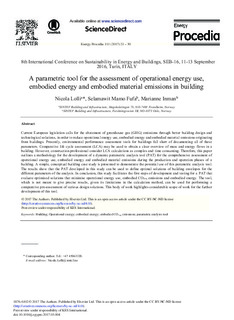| dc.contributor.author | Lolli, Nicola | |
| dc.contributor.author | Fufa, Selamawit Mamo | |
| dc.contributor.author | Wiik, Marianne Rose Kjendseth | |
| dc.date.accessioned | 2017-07-05T16:07:45Z | |
| dc.date.available | 2017-07-05T16:07:45Z | |
| dc.date.created | 2017-03-21T09:11:47Z | |
| dc.date.issued | 2017 | |
| dc.identifier.citation | Energy Procedia. 2017, 111 (C), 21-30. | nb_NO |
| dc.identifier.issn | 1876-6102 | |
| dc.identifier.uri | http://hdl.handle.net/11250/2447972 | |
| dc.description.abstract | Current European legislation calls for the abatement of greenhouse gas (GHG) emissions through better building design and technological solutions, in order to reduce operational energy use, embodied energy and embodied material emissions originating from buildings. Presently, environmental performance assessment tools for buildings fall short of documenting all of these parameters.
Comparative life cycle assessment (LCA) may be used to obtain a clear overview of mass and energy f lows in a building. However, construction professional consider LCA calculations as complex and time consuming. Therefore, this paper outlines a methodology for the development of a dynamic parametric analysis tool (PAT) for the comprehensive assessment of operational energy use, embodied energy and embodied material emissions during the production and operation phases of a building. A simple, conceptual building case study is presented to demonstrate the potential use of this parametric analysis tool. The results show that the PAT developed in this study can be used to define optimal solutions of building envelopes for the different parameters of the analysis. In conclusion, this study facilitates the first steps of development and testing for a PAT that evaluate optimised solutions that minimise operational energy use, embodied CO2eq emissions and embodied energy. The tool, which is not meant to give precise results, given its limitations in the calculation method, can be used for performing a comparative pre-assessment of various design solutions. This body of work highlights considerable scope of work for the further development of this tool. | nb_NO |
| dc.language.iso | eng | nb_NO |
| dc.publisher | Elsevier Ltd. | nb_NO |
| dc.rights | Attribution-NonCommercial-NoDerivatives 4.0 Internasjonal | * |
| dc.rights.uri | http://creativecommons.org/licenses/by-nc-nd/4.0/deed.no | * |
| dc.subject | Building technology | nb_NO |
| dc.subject | Operational energy | nb_NO |
| dc.subject | Embodied energy | nb_NO |
| dc.subject | Embodied CO 2eq emissions | nb_NO |
| dc.subject | Parametric analysis tool | nb_NO |
| dc.title | A parametric tool for the assessment of operational energy use, embodied energy and embodied material emissions in building | nb_NO |
| dc.type | Journal article | nb_NO |
| dc.type | Peer reviewed | nb_NO |
| dc.description.version | publishedVersion | nb_NO |
| dc.rights.holder | © 2017 The Authors. This is an open access article under the CC BY-NC-ND license (http://creativecommons.org/licenses/by-nc-nd/4.0/). | nb_NO |
| dc.subject.nsi | VDP::Technology: 500 | nb_NO |
| dc.source.pagenumber | 21-30 | nb_NO |
| dc.source.volume | 111 | nb_NO |
| dc.source.journal | Energy Procedia | nb_NO |
| dc.source.issue | C | nb_NO |
| dc.identifier.doi | 10.1016/j.egypro.2017.03.004 | |
| dc.identifier.cristin | 1459873 | |
| cristin.unitcode | 7401,30,40,0 | |
| cristin.unitcode | 7401,30,20,0 | |
| cristin.unitname | Arkitektur, byggematerialer og konstruksjoner | |
| cristin.unitname | Bygninger og installasjoner | |
| cristin.ispublished | true | |
| cristin.fulltext | original | |
| cristin.qualitycode | 1 | |

